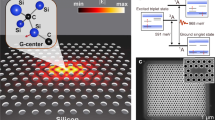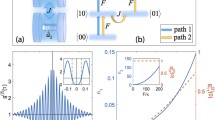Abstract
Optical gain that could ultimately lead to light emission from silicon is a goal that has been pursued for a long time by the scientific community. The reason is that a silicon laser would allow for the development of low-cost, high-volume monolithic photonic integrated circuits created using conventional CMOS technologies. However, the silicon indirect bandgap—requiring the participation of a proper phonon in the process of light emission—is a roadblock that has not been overcome so far. A high-Q optical cavity allowing a very high density of states at the desired frequencies has been proposed as a possible way to get optical gain. However, recent theoretical studies have shown that the free-carrier absorption is much higher than the optical gain at ambient temperature in an indirect bandgap semiconductor, even if a high-Q optical cavity is formed. In this work, we consider a particular case in which the semiconductor material is engineered to form an acousto-optical cavity where the photon and phonon modes involved in the emission process are simultaneously confined. The acousto-optical cavity confinement effect on the light emission properties is characterized by a compound Purcell factor which includes both the optical as well as the acoustic Purcell factor (APF). A theoretical expression for the APF is also introduced. Our theoretical results suggest that creating an acousto-optical cavity the optical gain can overcome the photon loss due to free carriers as a consequence of the localization of phonons even at room temperature, paving the way towards the pursued silicon laser.





Similar content being viewed by others
References
Altug, H., Vuckovic, J.: Photonic crystal nanocavity array laser. Opt. Express 13, 8819–8828 (2005)
Andreev, A.V., Emel’yanov, V.I., Il’inskii, YuA: Collective spontaneous emission (Dicke superradiance). Sov. Phys. Usp. 23, 493–514 (1980)
Ashcroft, N.W., Mermin, N.D.: Solid State Physics. Harcourt, New York (1976)
Boggess, T.F., Klaus, J.R., Bohnert, M., Mansour, K., Moss, S.C., Boyd, I.W., Smirl, A.L.: Simultaneous measurement of the two-photon coefficient and free-carrier cross section above the bandgap of crystalline silicon. IEEE J. Quantum Electron. 22, 360–368 (1986)
Chen, M.J., Tsai, C.S., Wu, M.K.: Optical gain and co-stimulated emissions of photons and phonons in indirect bandgap semiconductors. Jpn. J. Appl. Phys. 45, 6576–6588 (2006)
Dicke, R.H.: Coherence in spontaneous radiation processes. Phys. Rev. 93, 99–110 (1954)
Escalante, J.M., Martínez, A.: Theoretical study about the gain in indirect bandgap semiconductor optical cavities. Physica B 407, 2044–2049 (2012)
Escalante, J.M., Martínez, A.: Theoretical study about the relations among coefficients of stimulated emission, spontaneous emission and absorption in indirect bandgap semiconductor. Physica B 411, 52–55 (2013)
Fox, M.: Quantum Optics: An Introduction. Oxford UP, Oxford (2006)
Fujita, M., Tanaka, Y., Noda, S.: Light emission from silicon in photonic crystal nanocavity. IEEE J. Sel. Top. Quantum Electron. 14, 1090–1097 (2008)
Hofmann, M., Schmidt, C., Kohn, N., Rentsch, J., Glunz, S.W., Preu, R.: Stack system of PECVD amorphous silicon and PECVD silicon oxide for silicon solar cell rear side passivation. Prog. Photovoltaics 16, 509–518 (2008)
Iwamoto, S., Arakawa, Y., Gomyo, A.: Observation of enhanced photoluminescence from silicon photonic crystal nanocavity at room temperature. Appl. Phys. Lett. 91, 211104 (2007)
Kittel, C.: Introduccion to Solid State Physics, 8th edn. Wiley, New York (2004)
Lanzilloti-Kimura, N.D., Fainstein, A., Perrin, B., Jusserand, B., Soukiassian, A., Xi, X.X., Schlom, D.G.: Bloch oscillations of THz acoustic phonons in coupled nanocavity structures. Phys. Rev. Lett. 104, 197402 (2010)
Lipson, M.: Guiding, modulating, and emitting light on silicon-challenges and opportunities. J. Lightwave Technol. 23, 4222–4238 (2005)
Nakayama, S., Ishida, S., Iwamoto, S., Arakawa, Y.: Effect of cavity mode volume on photoluminescence from silicon photonic crystal nanocavities. Appl. Phys. Lett. 98, 171102 (2011)
Pavesi, L., Lockwood, D.J.: Silicon Photonics. Springer, New York (2004)
Purcell, E.M.: Spontaneous emission probabilities at radio frequencies. Phys. Rev. 69, 681 (1946)
Reed, G.T., Knights, A.P.: Silicon Photonics: An Introduction. John Wiley, West Sussex (2004)
Sturm, J.C., Reaves, C.M.: Silicon temperature measurement by infrared absorption. Fundamental processes and doping effects. IEEE Trans. Electron Dev. 39, 81–88 (1992)
Svantesson, K.G., Nilsson, N.G.: Determination of the temperature dependence of the free carrier and interband absorption in silicon at 1.06 \(\mu \)m. J. Phys. C Solid State Phys. 12, 3837–3842 (1977)
Ternon, C., Gourbilleau, F., Portier, X., Voivenel, P., Dufour, C.: An original approach for the fabrication of \(\text{ Si/SiO }_{2}\) multilayers using reactive magnetron sputtering. Thin Solid Films 419, 5–10 (2002)
Trigo, M., Bruchhausen, A., Fainstein, A., Jusserand, B., Thierry-Mieg, V.: Confinement of acoustical vibrations in a semiconductor planar phonon cavity. Phys. Rev. Lett. 89, 227402 (2002)
Trupke, T., Green, M.A., Wurfel, P.: Optical gain in materials with indirect transitions. J. Appl. Phys. 93, 9058–9061 (2003a)
Trupke, T., Zhao, J., Wang, A., Corkish, R., Green, M.A.: Very efficient light emission from bulk crystalline silicon. Appl. Phys. Lett. 82, 2996–2998 (2003b)
Tsai, C.-Y.: Theoretical model for the optical gain coefficient of indirect-band-gap semiconductors. J. Appl. Phys. 99, 053506 (2006)
Zadernovskii, A.A., Rivlin, L.A.: Stimulated two-quantum photon-phonon transitions in indirect-gap semiconductors. Sov. J. Quantum Electron. 21, 255–260 (1991)
Zadernovskii, A.A., Rivlin, L.A.: Photon-phonon laser action in indirect-gap semiconductors. Quantum Electron. 23, 300–308 (1993)
Acknowledgments
This research has received funding from the European Community’s Seventh Framework Programme (FP7/2007-2013) under grant agreement number 233883 (TAILPHOX).
Author information
Authors and Affiliations
Corresponding author
Rights and permissions
About this article
Cite this article
Escalante, J.M., Martínez, A. Optical gain by simultaneous photon and phonon confinement in indirect bandgap semiconductor acousto-optical cavities. Opt Quant Electron 45, 1045–1056 (2013). https://doi.org/10.1007/s11082-013-9715-z
Received:
Accepted:
Published:
Issue Date:
DOI: https://doi.org/10.1007/s11082-013-9715-z




